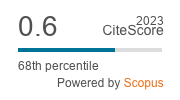Ozna/Udba: Records of Enemies and their Categorisation (1940s and 1950s)
DOI:
https://doi.org/10.22586/csp.v49i1.6Keywords:
Croatia; Democratic Federative Yugoslavia (DFJ); Federative People’s Republic of Yugoslavia (FNRJ); Department for People’s Protection (OZNA); State Security Administration (UDBA); Communist Party of Yugoslavia (KPJ)Abstract
The security and intelligence system of the Communist Party of Yugoslavia (Komunistička partija Jugoslavije – KPJ) and the Partisan movement was institutionalised through intelligence centres (obavještajni centri – OC, late 1942), the Department for People’s Protection (Odjeljenje za zaštitu naroda – OZNA, May 1944), and the State Security Administration (Uprava državne bezbjednosti – UDBA, March 1946) and gradually created a system of recording and categorising enemies. The author uses key documents regarding the establishment of the security and intelligence system, instructions given by its leadership, and reports of security and intelligence bodies from Croatia in order to reconstruct the way in which records of armed enemies and political opponents were made and according to which criteria such people were categorised. At the beginning of the war, this matter wasn’t given much consideration, but with the gradual strengthening of the Partisan units i.e. the People’s Liberation Army and Partisan Detachments of Yugoslavia (Narodno-oslobodilačka vojska i partizanski odredi Jugoslavije – NOV i POJ), later the Yugoslav Army (Jugoslavenska armija – JA) and their establishment of control over larger areas, and even more so at the end of the war and in its immediate aftermath as well as after the establishment of Democratic Federative Yugoslavia (Demokratska Federativna Jugoslavija – DFJ) and later the Federative People’s Republic of Yugoslavia (Federativna Narodna Republika Jugoslavija – FNRJ), the need for making such records became a pressing matter. Therefore, during the early phase of building this security and intelligence system, its main focus was on recording and categorising wartime enemies. Security and intelligence operatives reported on the state of affairs in the occupied territories, the number of enemy soldiers and their armament, and enemy military plans. However, the category of “class” i.e. political and ideological enemy was soon introduced, according to which the population’s stance towards the Partisan movement became a subject of interest. Therefore, political opponents such as members and supporters of “bourgeois” political parties, the clergy, and people who possessed a certain amount of property, especially owners of various types of shops, stores, and enterprises were all considered potential enemies. Records were kept on Ustashas, Crusaders, Chetniks, Gestapo agents, members of the Croatian Peasant Party, priests, convicts, émigrés, informants working for Western intelligence services (particularly the British Intelligence Service), and also those who had familial ties to such people or were considered to be their friends. In addition to active enemies and political opponents, they also monitored all other citizens. Therefore, as the end of the war was approaching, the KPJ and OZNA strove to secure their dictatorship and a one-party system in which there would be no room for opposition activity. With the establishment of the UDBA and the forming of separate departments and offices for various groups of armed, political, and ideological opponents, the security system was finally complete. Whether they were active or passive, living or dead, acting in the country or abroad, records were kept on all enemies and political opponents as well as their family members and friends. Unfortunately, these claims can be substantiated only with fragmentary data since full lists for Croatia or some of its larger or smaller territorial units such as districts (okrugs) or provinces (oblasts) are unavailable, at least for the 1940s and early 1950s. However, lists and reports of security and intelligence services regarding the number and types of enemies are available for certain smaller areas, such as districts or cities, or at least for some categories of enemies, such as those sentenced to death by the courts or without trial, active enemies of the people, former convicts, suspicious persons, and émigrés. They prove that records were kept on almost all types of enemies. The same conclusion applies to the monitoring of all other citizens, since all those working in state institutions and mass organisations – such as women’s and youth organisations – were monitored, as were critically-minded individuals. The main goal of the communist authorities and their security and intelligence services was to have a complete insight into enemy activities, rival political forces, and possible discontent among their own citizens so as to nip any opposing political activity in the bud.
Downloads
Published
How to Cite
Issue
Section
License
Copyright (c) 2017 authors and journal

This work is licensed under a Creative Commons Attribution-NonCommercial 4.0 International License.
Copyright holders are the publisher Croatian Institute of History and the authors. Journal of Contemporary History is an Open Access journal. Users are allowed to read, download, copy, redistribute, print, search and link to material, and alter, transform, or build upon the material, or use them for any other lawful purpose as long as they attribute the source in an appropriate manner according to the Creative Commons licence CC BY-NC. The papers published in Journal of Contemporary History can be deposited and self-archived in the institutional and thematic repositories providing the link to the journal's web pages and HRČAK. Journal does not charge article processing charges (APC). The editors assume no responsibility for statements of fact or opinion made by contributors.




